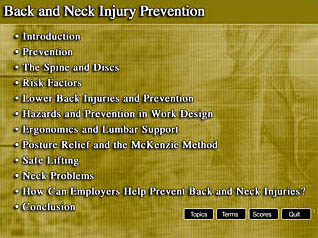Backs: Back and Neck Injury Prevention

- Product ID
- moxibnip
- Training Time ?
- 92 to 184 minutes
- Language(s)
- English
- Video Format
- Standard Definition
- Required Plugins
- MasteryNet Player
- Lesson Interactions
- 14
- Quiz Questions
- 38



Online Back Injury Prevention Training
Back Injury Prevention Training teaches about the effects of back and neck injuries. You'll learn about disc structure and disc degeneration. Most importantly, in this back safety training course you will learn about risk factors, lifestyle and other contributors to chronic back and neck problems and how to avoid them. You will also learn back injury prevention by using good ergonomic lifting techniques and the importance of good ergonomic work design. Back Injury Prevention Training qualifies for continuing education units.
![]() This course is in the Advantage™ format, to read about Advantage™ features click here.
This course is in the Advantage™ format, to read about Advantage™ features click here.

- Install on any SCORM LMS
- Rich multimedia presentation with interactions and quiz
- Print certificate and wallet card
- You have 30 days to complete the course
All workers.
-
Prevention
- Affects of back or neck injuries
- Cure for back or neck injuries
-
The Spine and Discs
- Disc structure
- Disc degeneration
- Causes of disc degeneration
-
Risk Factors
- Seated position
- Cumulative trauma
- Lifestyle contributors
- Curvature of the spine
- Standing too long
- Flexion
-
Lower Back Injuries and Prevention
- Ergonomic chairs
- Sciatic Nerve
- Effects of lumbar disc
- Poor lifting technique
-
Hazards and Prevention in Work Design
- Tool weight
- WUPR
- Bending over
- Back surgery
-
Ergonomics and Lumbar Support
- Engineering
- Ergonomic strategies and principles
- Lumbar support
- Lumbar support while driving
-
Posture Relief and the McKenzie Method
- Upper body support technique
- Posture relief
- McKenzie Method
-
Safe Lifting
- Ergonomic devices to avoid heavy lifting
- BLAST
-
Neck Problems
- Neck ergonomics
- Vision affects posture
- Neck extensions
- Vertebral Artery
- Pinched nerve
- Neck exertion
- Lifestyle risk factors
-
How Can Employers Help?
- How employers can help
-
Agree that backs can be damaged at any time.
- Explain why surgery isn't the answer to back pain.
-
Understand the problems associated with back or neck injuries.
- Identify the best cure for back or neck pain.
-
Be aware of the discs in the back.
- Name the parts of the discs.
- Recall how the blood flows through the discs.
- Explain why humans have so much back pain.
-
Prevent back and neck injuries in the workplace.
- List the causes of back or neck injuries in the workplace.
- Recognize that no posture is safe if constantly maintained.
- Understand what the spine is supposed to look like naturally.
- Recall what lifestyle factors contribute to back pain.
-
Use lumbar support when needed.
- Identify when lumbar support should be used.
- Recognize when you start feeling pain in the discs.
-
Know all the causes of back pain at in the workplace.
- List ways to reduce risks at work.
-
Use ergonomic strategies to reduce the risk of back injuries.
- List the ergonomic strategies for reducing risk of back injuries.
- Repeat what sound ergonomics calls for reducing.
-
Understand how back injuries can occur while driving.
- Discuss how posture relief methods help prevent back injuries.
- Define the McKenzie Method.
-
Prevent lifting injuries.
- List methods to eliminate lifting injuries.
- Define the BLAST technique.
-
Prevent neck injuries.
- Recall how the worst neck injuries can occur.
- Identify proper monitor placement when working at a computer.
- List the various injuries caused by neck extensions.
- Be aware of how employers can make the workplace safe.
© Mastery Technologies, Inc.



